Grid Dynamics Bundle
How Does Grid Dynamics Stack Up in the Digital Engineering Arena?
In today's fast-paced digital world, businesses are racing to transform, making the digital engineering services market incredibly competitive. Grid Dynamics, a key player since 2006, helps Fortune 1000 companies navigate this complex landscape with its cutting-edge solutions. But how does Grid Dynamics maintain its edge and where does it stand in the face of fierce competition?
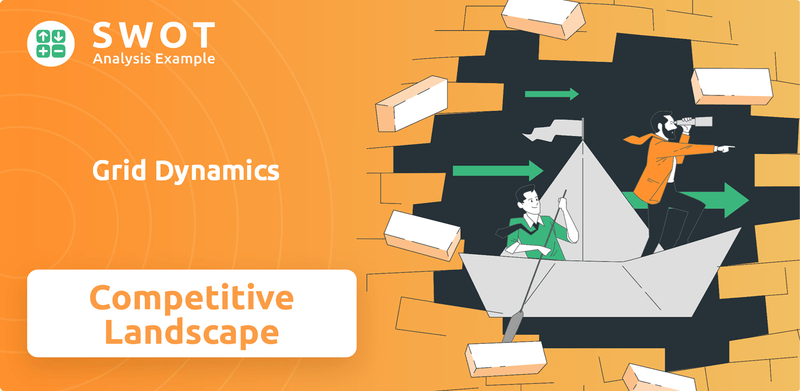
This analysis dives deep into the Grid Dynamics SWOT Analysis, exploring its competitive landscape, key competitors, and market position to provide a comprehensive understanding. We'll examine Grid Dynamics' strengths and weaknesses, analyze its financial performance, and assess its growth strategy within the dynamic IT services market. Understanding the Grid Dynamics competitive landscape is crucial for anyone making investment decisions or analyzing the future outlook of digital transformation.
Where Does Grid Dynamics’ Stand in the Current Market?
The company holds a significant position in the digital engineering services market, especially for large enterprises. It focuses on advanced solutions in cloud, data, and AI. While specific market share figures are not readily available as of early 2025, its growth and strategic partnerships indicate a strong foothold in its target segments. The company primarily serves Fortune 1000 companies, with a strong presence in retail, financial services, and technology.
The company's services accelerate innovation, modernize infrastructure, and create personalized customer experiences. Geographically, it has expanded globally, serving clients across North America, Europe, and Asia. The company has strategically shifted from traditional IT services to specialize in complex digital transformation initiatives. This move highlights a focus on premium, high-value consulting and implementation services.
This strategic repositioning is supported by its financial performance, with recent reports showing revenue growth and profitability often exceeding industry averages for specialized digital transformation providers. For instance, the company reported Q4 2023 revenue of $77.8 million, a 1.2% sequential increase, and a full-year 2023 revenue of $309.8 million. The company anticipates Q1 2024 revenue to be between $76.0 million and $78.0 million. This financial health underscores its strong market position, especially in regions with accelerating digital adoption.
The company's market position is strong within the digital engineering services sector. It targets large enterprises with advanced solutions in cloud, data, and AI. The company's focus on digital transformation initiatives and its global presence contribute to its market strength.
The company's financial performance reflects its strong market position. Q4 2023 revenue was $77.8 million, and full-year 2023 revenue reached $309.8 million. The company anticipates Q1 2024 revenue to be between $76.0 million and $78.0 million, indicating continued growth.
The company specializes in accelerating innovation, modernizing infrastructure, and creating personalized customer experiences. Its services are geared towards complex digital transformation initiatives. This strategic focus differentiates it within the competitive landscape.
The company serves clients across North America, Europe, and Asia. This global presence allows it to cater to a diverse range of industries and clients. Its international reach supports its growth strategy.
The company's key strengths include its focus on digital transformation, strong financial performance, and global presence. Its ability to serve Fortune 1000 companies and its expertise in cloud, data, and AI solutions are also significant. These strengths contribute to its competitive advantages.
- Focus on digital transformation initiatives.
- Strong financial performance with consistent revenue growth.
- Global presence, serving clients across North America, Europe, and Asia.
- Expertise in cloud, data, and AI solutions.
- Serving Fortune 1000 companies.
Grid Dynamics SWOT Analysis
- Complete SWOT Breakdown
- Fully Customizable
- Editable in Excel & Word
- Professional Formatting
- Investor-Ready Format
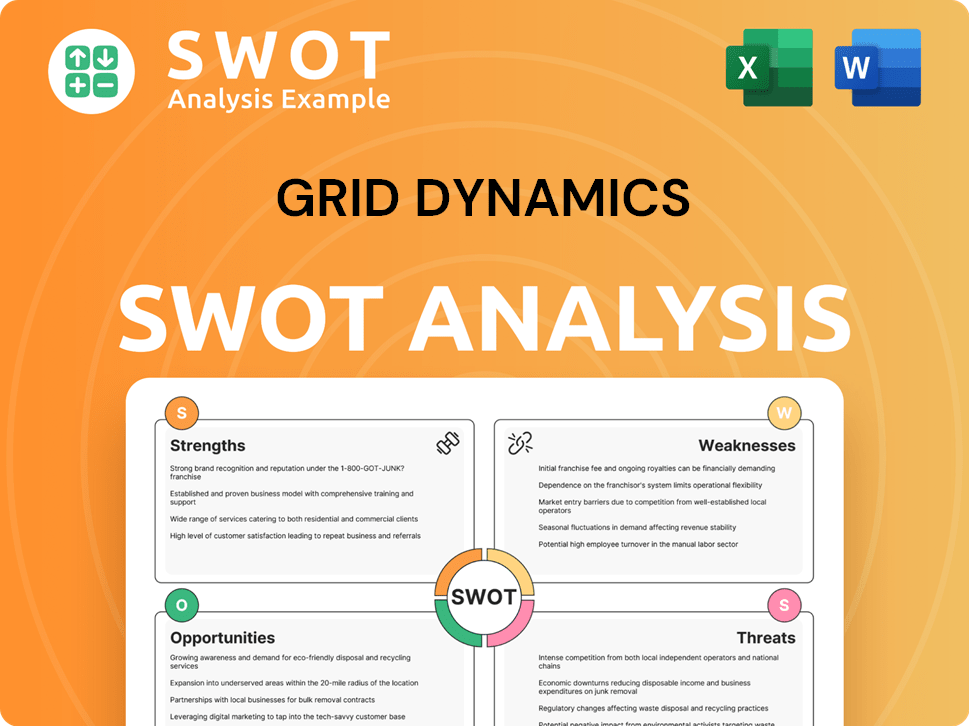
Who Are the Main Competitors Challenging Grid Dynamics?
The competitive landscape for Grid Dynamics is complex, shaped by a diverse set of players in the digital engineering services market. Understanding its rivals is crucial for assessing its market position and growth potential. This analysis considers both direct and indirect competitors, highlighting the key differentiators and competitive dynamics at play. For a deeper dive into its financial strategies, consider exploring Revenue Streams & Business Model of Grid Dynamics.
Grid Dynamics faces competition from established IT consulting giants and specialized digital transformation agencies. These competitors vie for market share by offering similar services, including digital engineering, cloud solutions, data analytics, and AI. The competitive environment is further influenced by mergers, acquisitions, and emerging technologies, which constantly reshape the industry.
The company's market position is influenced by its ability to differentiate itself through expertise, delivery models, and pricing strategies. The competitive landscape is dynamic, with companies constantly adapting to changing market demands and technological advancements. This makes it essential to continually analyze and understand the strategies of key competitors.
Direct competitors offer similar services and target the same customer segments. They often compete head-to-head for projects and contracts. These companies focus on digital engineering, cloud services, data analytics, and AI solutions, competing for enterprise clients across various industries.
EPAM Systems is a major player, offering a wide range of software engineering and IT consulting services globally. EPAM's broad service portfolio and global presence make it a significant competitor. In 2024, EPAM reported revenues of approximately $4.69 billion.
Luxoft, now part of DXC Technology, provides digital transformation services, including software development and IT consulting. Luxoft's focus on digital transformation and its client base make it a direct competitor. DXC Technology reported revenues of $14.4 billion in fiscal year 2024.
Endava offers digital transformation services, focusing on agile software development and IT consulting. Endava's specialization in digital transformation and its client base make it a direct competitor. Endava's revenue for the fiscal year 2024 was approximately $895 million.
GlobalLogic, acquired by Hitachi Vantara, provides digital engineering services, including product engineering and digital transformation. GlobalLogic's focus on digital engineering and its client base make it a direct competitor. Hitachi Vantara's revenue for fiscal year 2024 was approximately $10.4 billion.
Indirect competitors have broader service offerings but compete with Grid Dynamics in specific areas. These companies often have strong digital transformation practices and compete for large-scale enterprise projects. They may offer a wider range of services, including IT consulting, systems integration, and business process outsourcing.
Accenture is a global leader in IT consulting and digital transformation, offering a wide array of services. Accenture's vast resources and global reach make it a formidable competitor. Accenture reported revenues of approximately $64.1 billion in fiscal year 2024.
Capgemini provides IT consulting, digital transformation, and technology services globally. Capgemini's strong digital transformation capabilities and client base make it a significant competitor. Capgemini's revenue for 2024 was approximately €22.5 billion.
TCS is a major IT services and consulting company with a strong digital transformation practice. TCS's global presence and comprehensive service offerings make it a key competitor. TCS's revenue for fiscal year 2024 was approximately $29.7 billion.
The Grid Dynamics competitive landscape is influenced by several factors, including mergers and acquisitions, technological advancements, and evolving customer demands. The Grid Dynamics industry analysis reveals that competition is intensifying, with both direct and indirect competitors continually adapting their strategies. The Grid Dynamics market position is affected by its ability to differentiate itself through specialized expertise, delivery models, and pricing. Grid Dynamics competitors are constantly innovating, and the company must stay agile to maintain its market share.
- Mergers and Acquisitions: Acquisitions, such as Hitachi’s purchase of GlobalLogic, consolidate market power and expand service portfolios, intensifying competition.
- Emerging Players: Boutique consultancies specializing in niche areas like AI/ML or specific cloud platforms pose a competitive threat.
- Technological Advancements: The rapid evolution of technologies like cloud computing, AI, and data analytics requires companies to continually update their skills and service offerings.
- Customer Demands: Clients increasingly seek end-to-end digital transformation solutions, requiring service providers to offer comprehensive capabilities.
- Pricing and Delivery Models: Competitive bidding for large-scale projects often hinges on specialized expertise, delivery models, and pricing strategies.
Grid Dynamics PESTLE Analysis
- Covers All 6 PESTLE Categories
- No Research Needed – Save Hours of Work
- Built by Experts, Trusted by Consultants
- Instant Download, Ready to Use
- 100% Editable, Fully Customizable
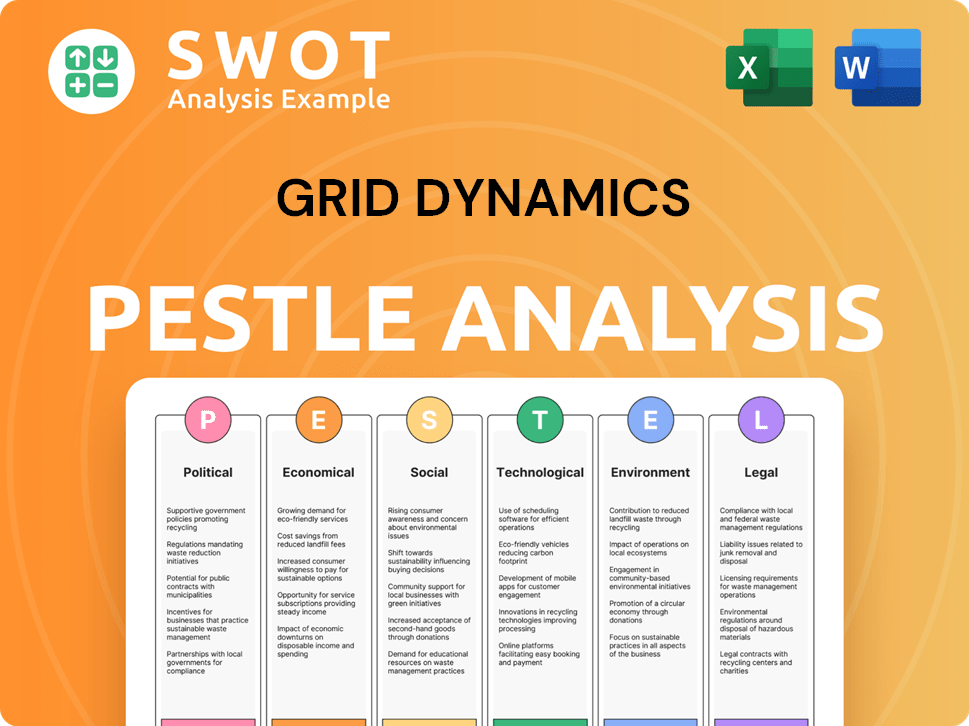
What Gives Grid Dynamics a Competitive Edge Over Its Rivals?
Understanding the Grid Dynamics competitive landscape requires a deep dive into its core strengths. The company's ability to deliver complex digital engineering projects, especially for Fortune 1000 companies, sets it apart. This focus allows it to cultivate a highly specialized talent pool, providing innovative solutions that address intricate enterprise challenges.
Grid Dynamics' market position is further solidified by its strong client relationships and a proven track record. Its approach includes seamless integration with client teams, offering end-to-end digital transformation services. The agile delivery model and emphasis on rapid prototyping provide a competitive edge, allowing clients to realize value faster.
The company's evolution from a technical execution focus to a strategic partnership approach underscores its adaptability. While competitors are investing heavily in similar capabilities, Grid Dynamics' established reputation and niche focus provide a sustainable lead in its target market. For a detailed look at the company's growth strategies, consider reading about the Growth Strategy of Grid Dynamics.
Grid Dynamics excels due to its deep technical expertise and specialized focus on complex digital engineering. They offer proprietary methodologies and accelerators, particularly for cloud adoption and AI integration. This focus allows them to deliver innovative solutions tailored to the specific needs of large enterprises.
Strong client relationships are a cornerstone of Grid Dynamics' success, fostering customer loyalty and repeat business. They integrate seamlessly with client teams, providing end-to-end digital transformation services. Their agile delivery model ensures rapid prototyping and iterative development, accelerating value realization for clients.
The company's focus on high-value digital engineering projects, particularly for Fortune 1000 companies, is a key differentiator. This focus allows them to cultivate a highly skilled talent pool. This specialized talent enables them to deliver innovative solutions that directly address the intricate challenges faced by large enterprises.
Grid Dynamics' agile delivery model and emphasis on rapid prototyping provide a competitive edge. They are known for their ability to quickly prototype and iterate, allowing clients to realize value faster. This approach supports their strategic partnership approach, moving beyond pure technical execution.
Grid Dynamics' competitive advantages include deep technical expertise, strong client relationships, and a focus on high-value projects. Their ability to deliver complex digital engineering solutions, particularly for large enterprises, sets them apart. The agile delivery model and emphasis on rapid prototyping further enhance their value proposition.
- Proprietary Methodologies: Utilizing proprietary methodologies and accelerators for cloud adoption, data modernization, and AI integration.
- Talent Pool: Cultivating a highly skilled talent pool with expertise in cutting-edge technologies.
- Client Relationships: Leveraging strong client relationships and a proven track record of successful project delivery.
- Agile Delivery: Employing an agile delivery model with rapid prototyping and iterative development.
Grid Dynamics Business Model Canvas
- Complete 9-Block Business Model Canvas
- Effortlessly Communicate Your Business Strategy
- Investor-Ready BMC Format
- 100% Editable and Customizable
- Clear and Structured Layout
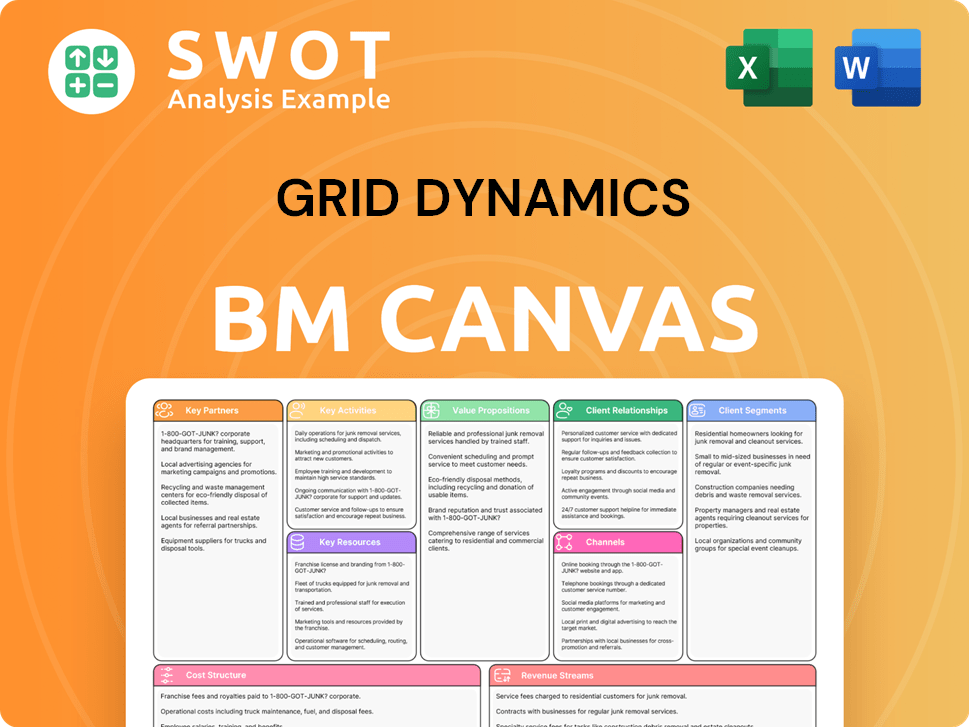
What Industry Trends Are Reshaping Grid Dynamics’s Competitive Landscape?
The digital engineering services industry is experiencing rapid transformation, driven by advancements in generative AI, cloud migration, and the demand for hyper-personalized customer experiences. This dynamic environment presents both opportunities and challenges for companies like Grid Dynamics. Understanding the Grid Dynamics competitive landscape requires a close look at industry trends, potential risks, and future growth prospects.
Grid Dynamics' market position is influenced by its ability to adapt to these changes, maintain a technological edge, and attract top talent. The company's success hinges on its strategic investments in research and development, as well as its capacity to form strategic partnerships and expand its service offerings. A thorough Grid Dynamics industry analysis is crucial for evaluating its potential.
Generative AI is rapidly changing the digital engineering services landscape, offering new opportunities for innovation and automation. Cloud migration continues to be a major trend, with businesses increasingly relying on cloud-based solutions. Hyper-personalization is becoming crucial for customer experience, driving demand for tailored digital solutions.
The need for continuous upskilling of talent is a significant challenge in the face of rapidly evolving technologies. Managing data privacy and security in complex environments requires robust strategies. Navigating evolving regulatory landscapes adds complexity to operations. The threat from new market entrants specializing in niche areas also poses a risk.
Emerging markets offer significant growth potential for digital engineering services. Expanding service offerings to include specialized AI consulting can create new revenue streams. Forming strategic partnerships can broaden reach and capabilities. There's a growing need for advanced solutions to address complex business challenges.
Grid Dynamics competitors include companies like Cognizant, Accenture, and EPAM Systems, among others. The competitive landscape is intense, with firms vying for market share in a rapidly expanding sector. Differentiation through specialized services and technological expertise is key.
To maintain its competitive edge, Grid Dynamics must continually adapt its strategies. This involves a focus on AI-driven solutions, industry-specific platforms, and strategic acquisitions. The company's financial performance and ability to secure and retain top talent will be critical factors in its future success. For more insights, consider reading about the Growth Strategy of Grid Dynamics.
Grid Dynamics' Grid Dynamics market position is influenced by its ability to innovate and adapt to industry changes. The company's Grid Dynamics services must remain competitive to secure and retain clients. The company's Grid Dynamics financial performance will depend on its ability to execute its growth strategy.
- Investment in AI and cloud technologies.
- Strategic partnerships to broaden service offerings.
- Focus on industry-specific solutions.
- Talent acquisition and retention strategies.
Grid Dynamics Porter's Five Forces Analysis
- Covers All 5 Competitive Forces in Detail
- Structured for Consultants, Students, and Founders
- 100% Editable in Microsoft Word & Excel
- Instant Digital Download – Use Immediately
- Compatible with Mac & PC – Fully Unlocked
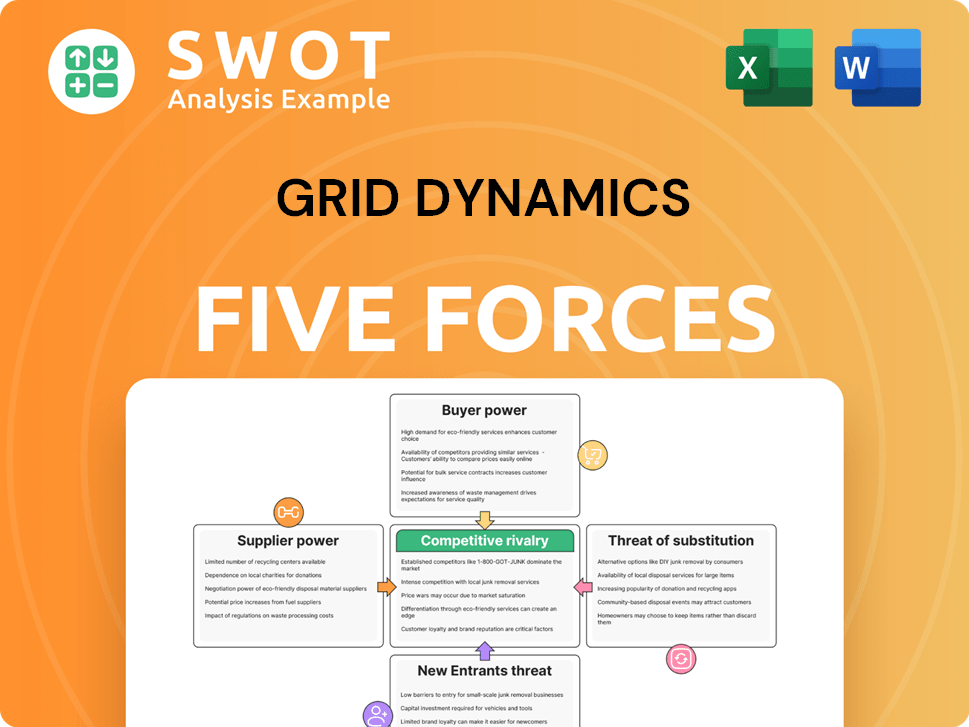
Related Blogs
- What are Mission Vision & Core Values of Grid Dynamics Company?
- What is Growth Strategy and Future Prospects of Grid Dynamics Company?
- How Does Grid Dynamics Company Work?
- What is Sales and Marketing Strategy of Grid Dynamics Company?
- What is Brief History of Grid Dynamics Company?
- Who Owns Grid Dynamics Company?
- What is Customer Demographics and Target Market of Grid Dynamics Company?
Disclaimer
All information, articles, and product details provided on this website are for general informational and educational purposes only. We do not claim any ownership over, nor do we intend to infringe upon, any trademarks, copyrights, logos, brand names, or other intellectual property mentioned or depicted on this site. Such intellectual property remains the property of its respective owners, and any references here are made solely for identification or informational purposes, without implying any affiliation, endorsement, or partnership.
We make no representations or warranties, express or implied, regarding the accuracy, completeness, or suitability of any content or products presented. Nothing on this website should be construed as legal, tax, investment, financial, medical, or other professional advice. In addition, no part of this site—including articles or product references—constitutes a solicitation, recommendation, endorsement, advertisement, or offer to buy or sell any securities, franchises, or other financial instruments, particularly in jurisdictions where such activity would be unlawful.
All content is of a general nature and may not address the specific circumstances of any individual or entity. It is not a substitute for professional advice or services. Any actions you take based on the information provided here are strictly at your own risk. You accept full responsibility for any decisions or outcomes arising from your use of this website and agree to release us from any liability in connection with your use of, or reliance upon, the content or products found herein.